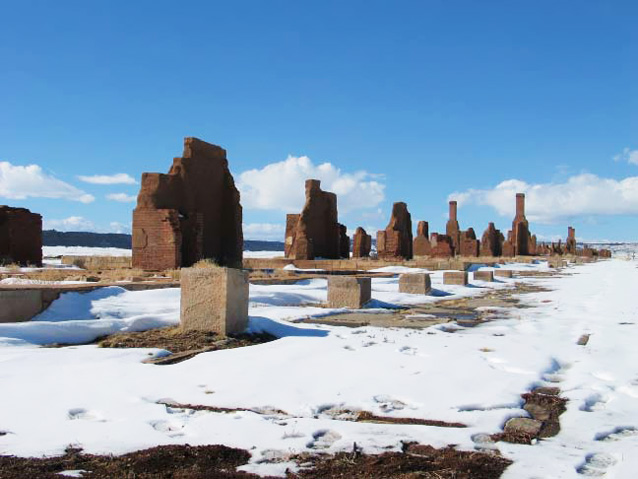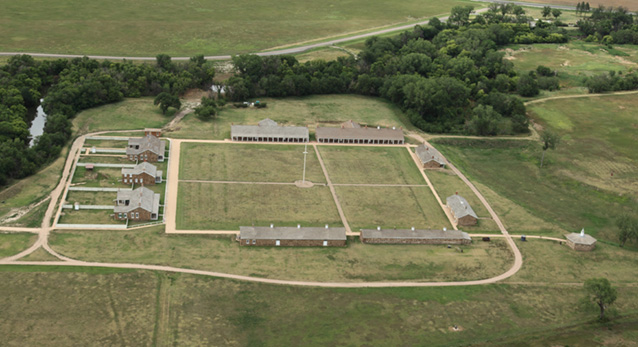The U.S. opened military forts along the route of the Santa Fe Trail to protect trail travel and trade.
The first military fort established, Fort Leavenworth in eastern Kansas, is not within the National Park Service. This fort was opened in 1827 to protect travelers on the Santa Fe and Oregon Trails; after the Mexican War, it was also the center for wagon freighting operations that supplied the military posts in the Southwest. The next fort, Fort Union, was established in 1851 near the western end of the Trail. It was an important military supply depot and became the largest military post in the Southwest. The fort also saw action during the Civil War. Eight years after Fort Union, Fort Larned was opened near the mid-point of the Trail to protect trail travelers. Bent’s Fort, not a military fort but a trading post, was built in 1833. It was established by William and Charles Bent and Ceran St. Vrain to engage in trade with Plains Indians and trappers.
Fort Union
Fort Union was established in 1851 as the guardian of the Santa Fe Trail. It commanded the intersection of the Mountain and Cimarron Branches of the Trail. Fort Union served both military and civilian functions. Prior to the Civil War, the fort’s troops patrolled the trail and, later, escorted mail stages. During the Civil War, the combination of Native American conflicts and raids by Confederates from Texas led to the troops’ protection of all travelers and efforts to keep open the Santa Fe Trail. Three different forts were built close together on the site during its forty-year history. The third Fort Union was the largest in the American Southwest and functioned as a military garrison, territorial arsenal, and military supply depot for the Southwest. The railroad bypassed Fort Union in 1879, and its supply operations were gradually phased out. 1883 saw the closure of the depot. Today at Fort Union National Monument (FOUN), one can tour fort remains and see the largest visible network of Santa Fe Trail ruts.

NPS
Fort Larned

Don Stivers / Courtesy of Stivers Publishing
Fort Larned was established on the western Kansas prairie for the protection of mail coaches, freighters, and other traffic on the Trail. Operating from 1860 through the late 1870s, it was the most important military post guarding the northern portion of the Trail. The fort was also the site of an Indian Agency, and therefore important in maintaining amicable relations with Plains Indians. Also of note, Fort Larned was the first military installation to receive for duty one of the newly formed African American cavalry regiments known as Buffalo Soldiers. Company A of the 10th Cavalry arrived in April of 1867 with nearly 100 men (Walker 1997). Buffalos Soldiers are noted for having played a major role in the settlement and development of the West and for their dedication and bravery under harsh conditions and racial prejudice. Today, Fort Larned NHS (FOLS) has nine restored buildings with which to explore and imagine military life on the Trail. During parts of the year, staff and volunteers at FOLS dress in period clothing and man the fort.

NPS
Bent’s Fort (Bent’s Old Fort)
The original adobe fort at Bent’s Old Fort National Historic Site (BEOL), built by William Bent in 1833, became the center of the establishing company’s trading business; they also established Fort St. Vrain to the north and Fort Adobe to the south, as well as stores in Mexico at Taos and Santa Fe. Bent’s Fort became one of the most significant trading posts in the West. Trade was primarily with the Southern Cheyenne and Arapaho Indians for buffalo robes. The fort was the only major permanent white settlement on the Santa Fe Trail for much of its history. It provided supplies, rest, and protection to a variety of visitors, including the U.S. Army. During the war with Mexico, the fort was used as a staging area for Colonel Stephen Watts Kearny and his Army of the West. Bent’s Fort was burned and abandoned in 1849 due to a cholera epidemic spreading through the Native American tribes (USDOI 1976). In 1852-53, Bent built a new fort (Bent’s New Fort) downstream on the Arkansas River to reestablish the Indian trade. Several years later, Fort Lyon (originally called Fort Wise) was established nearby and served as a guardian of the Mountain Branch of the Trail during the Civil War.

NPS
Today, BEOL features a reconstructed 1840s adobe fur trading post. The fort was reconstructed in 1976 using original sketches, paintings, diaries, and archeological excavations. Living historians recreate the past with guided tours, demonstrations, and special events.
Part of a series of articles titled The Santa Fe Trail.
Last updated: August 11, 2016
